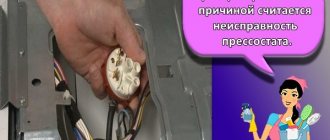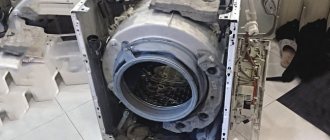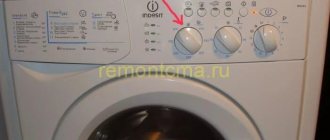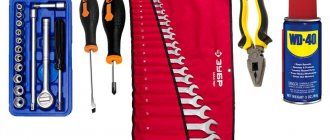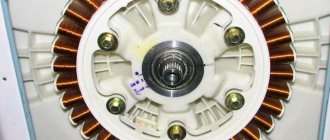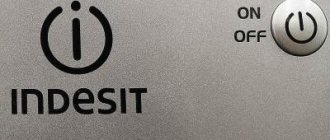Acting as the first assistant in household chores, the washing machine becomes an indispensable household appliance. Its failure causes a lot of inconvenience. The appearance of malfunction signals in the form of program failure during the washing process, in most cases, is associated with the operation of the drain system. The pump in the washing machine may become clogged and should be cleaned as soon as possible. Otherwise, you will have to eliminate a more serious problem that it can lead to.
Why do you need a pump?
The water pump is an important element of an automatic washing machine (WMA). It is an asynchronous type motor that creates vortex flows of water. If we compare the structure of a washing machine with the human body, then the pump is a “heart” that drives “blood” - water, through the inside of the machine. The element is located in the bowels of the machine. It is secured with plastic brackets. There is a filter that traps debris and foreign bodies.
If you clean the unit in question in a timely manner, you can significantly extend its service life. If it breaks, no one will repair it - usually this part is simply replaced. Many housewives do not even suspect that the “insides” of the machine need to be cleaned periodically. To avoid breakdowns, it is recommended to clean the unit in question at least once a year.
Removing the rear panel
When deciding how to clean the pump in the Electrolux and Zanussi washing machines, you will have to remove the back cover. For this:
- Disconnect the inlet hose from the housing.
- Remove the screws holding the cover in place.
Now disconnect and remove the drain pump. If you are disassembling for the first time, it is better to record the repair on camera. This will make it easier for you to assemble everything correctly.
Principle of operation
When the machine is running, water enters it under pressure. Once you select the desired program and click “Start”, water will begin to flow into it. Further work goes like this:
- the solenoid valve opens;
- the control sensor (pressostat) measures the required volume of water;
- the liquid passes through the compartments with the powder and enters the tank;
- Water under pressure is supplied to the chamber containing the laundry.
The pump works both during washing and after it is completed. It is needed to drain and pump out waste water after washing or rinsing. But she does not participate in the spin cycle. Having received a signal from the control module, the engine pumps dirty water into the sewer. It flows through a rubber pipe connecting the tank and the volute with special clamps.
The dirty liquid then passes through the filter and enters the pump. The filter device is located inside the scroll - it traps debris, preventing it from getting onto the impeller. The liquid then flows through the drain hose into the sewer.
What will be needed for verification?
The diagnosis itself is not difficult if the following tools are available:
Rice. 1 - Diagnostic tools
- multimeter (a tester is enough);
- medium-sized pliers;
- screwdrivers – Phillips and flathead;
- awl.
To find out if there are problems with the drain pump, it must be removed from the machine.
Where is the water pump located?
It is located at the bottom - under the tank, and is fastened to the plastic snail with several (usually three) self-tapping screws. The snail itself is attached to the body. It is located so that, if necessary, it can be easily cleaned of dirt.
Two types of pumps are used in SMA:
- Circulation. They are installed in premium class machines - Indesit, Ariston, etc. Water is supplied directly to the washing area and at the same time circulates through the system - this improves the quality of washing clothes.
- Simple. These are installed in budget cars. They simply send dirty water down the drain.
Before inspecting the device for blockages and then cleaning it, the equipment is de-energized. Using a special device - a multimeter, check the contacts suitable for the pump. You need to be sure that there is no tension on it before you start disassembling. Technical characteristics of the drain pump:
- power - 25–40 kW;
- fastening with a snail - screws or latches;
- contacts - separate/paired.
The nodes under consideration may differ in the type of cochlea. If the drain is clogged, not all of the water flows out of the chamber; due to the stagnation of dirty liquid, a musty, putrid odor appears. The first action when an odor appears is to check the filter. Sometimes cleaning the latter is enough to solve the problem.
Preventing drain clogging.
To increase the service life, maintenance of equipment is necessary. Of course, each unit has its own resource, but neglect can shorten its service life. Some tips on how to avoid frequent contamination of the drain system:
- Use powders designed for washing machines.
- It is better to pre-rinse heavily soiled items in a separate container.
- Clothes decorated with small elements should not fall into the washing machine drum or be washed in a special bag.
- Be sure to install a filter for the machine at the water intake point.
- If you notice any extraneous sounds or increased operating noise of the machine when draining, you should disassemble (at the end of the washing process) the drain system and remove debris from the hose and pump.
All manipulations associated with washing and caring for the machine can be easily done if you follow the basic rules for operating the equipment.
Why did the blockage happen?
During the operation of the SMA, alarming signs may appear:
- Water drainage is unusually slow.
- A buzzing sound is heard when pumping. The efforts of a device that wears out do not lead to results.
The diagnosis is clear - the pump is clogged. Causes of clogging:
- Debris and contaminants that come with water from water pipes.
- Debris and small objects that fall into the drum along with clothes placed in the wash.
- Poor-quality detergents - they clog the drain if they do not dissolve completely.
It happens that owners of automatic washing machines never clean the drain when using them. But no matter how “smart” and efficient the machine is, no matter what famous brand it represents - Samsung, Ariston, Electrolux or Indesit, they all need regular cleaning of all parts that come into contact with water. Cleaning the drain assembly is difficult because you still need to get to it.
Preventive measures
You can protect your washing machine from breakdowns, especially from clogging of the pump (drain sediment). To do this, you need to adhere to the following recommendations:
- Carefully check the pockets of items before washing for the presence of foreign objects (for example, small money, metal or plastic objects). These parts can damage the inside of the pump or block the drain hose.
- Soften washing water. Synthetic products (Kalgon, Uplon, Kupava) and special filters will help with this. The former remove plaque formed by small particles of salts and metals (components of hard water), and filters prevent these particles from penetrating inside the washing machine.
- Do not overload the device (load the amount of dirty laundry into the drum as recommended by the manufacturer).
Regular cleaning of the filter, which is located between the pump and the drain hose, will also help protect the machine from such damage. By following these rules, you can protect the device from damage.
How to get to the pump?
The process of removing the unit depends on the design of the washer. Take a basin for draining water and a simple set of tools:
- wrench;
- screwdrivers - Phillips and flat.
Before disassembling, be sure to familiarize yourself with the structure of the device; it is important to determine the exact location of the unit you are interested in. The procedure depends on the design features of a particular model.
Through the bottom
- There should be a panel or door at the bottom through which you can reach the pump. Open it by prying it open with a screwdriver. Find the screw that secures the drain filter and unscrew it.
- Tilt the device and let the remaining water pour into the basin prepared in advance. Turn the filter device clockwise: this will allow all the liquid to drain out.
- Now twist the filter clockwise and, pressing it into the housing, remove it through the bottom.
- Disconnect the hose, wires and clamps - now you can remove the pump.
Important! All actions to disassemble the washing machine must be carried out after disconnecting it from the power supply and turning off the water supply tap.
Through the façade
- Take out the detergent container and unscrew the screw located at the bottom.
- At the bottom, remove the panel to access the filter. Unscrew the second screw and remove the front panel.
- Having found an internal panel under the front panel, screwed with self-tapping screws, unscrew them too. Disconnect the cuff, remove the clamp from the hatch and release the clamps. Having reached the desired unit, drain the water, disconnect the hose and other elements.
Through the back wall
- Unscrew the clamps that secure the drain hose and disconnect it. Unscrew the screws securing the back wall and remove it.
- Disconnect the wires and unscrew the pump.
When the unit is removed, begin cleaning it.
We clean and repair the pump on a washing machine ourselves
If the washing machine malfunctions when filling or draining water, the cause may be a broken pump. You can replace or repair a broken washing machine pump yourself. Let's look at the causes of the breakdown, questions about self-repair, and tips for keeping the machine in working condition.
The article is relevant for the following brands and models: Ardo / Ardo, Beko / Beko / Veko; Bosch Logixx, Maxx / Bosch Logixx, Max; Brandt / Brandt, Candy Grand, Holiday / Kandy Grand, Holiday; Daewoo / Daewoo, Electrolux EWS, EWT / Electrolux; Gorenje / Gorenje, Haier / Hayer, Hansa / Hansa, Hotpoint Ariston Aqualtis / Hotpoint Ariston Aqualtis; Indesit / Indesit, LG / LG/LV; Panasonic / Panasonic, Samsung Diamond / Samsung Diamond; Whirlpool / Whirlpool, Zanussi / Zanussi, Atlant, Vyatka, Fairy, Ocean and others, including automatic models (SMA), with vertical loading and direct drive.
Signs and causes of breakdowns
You can tell whether the pump is broken or not by these signs:
- the washing machine does not work according to the program set when washing began;
- The machine turns off completely when filling with water;
- when filling or draining water, humming or extraneous sounds appear - for example, something is buzzing;
- The water level in the drum is less than it should be.
Reasons for failure:
- lack of voltage on the pump due to engine malfunction;
- Damage to the seal (rubber or plastic) due to scale and dirt settling on the impeller;
- destruction of the impeller and the appearance of extraneous sounds during startup;
- constant operation of the pump due to incorrect connection or breakdown of the water level sensor;
- The filter is clogged, which makes it impossible to drain water.
Also read what to do if the machine does not drain water.
A little theory
A washing machine drain pump or pump is a mechanism that pumps water and detergent out of the tank. A special electric motor starts the pump. It can have a power from 30 to 120 W and a frequency of up to 3000 rpm. The pump takes part in almost all washing modes - this ensures water circulation in the machine and better removal of dirt from things.
Principle of operation. Draining dirty water occurs like this: water enters through a rubber pipe, which is connected to the tank and volute using special clamps. The liquid enters the pump through a special filter located in the volute - it protects the pump impeller from foreign objects. The water then comes out through a drain hose connected to the volute.
How to remove the pump
To repair the pump yourself, you need to know where it is and how to get to it. In different washing machines it can be located behind the back wall, behind the front panel or at the bottom of the machine:
- for Zanussi and Electrolux the pump is located on the back of the machine, behind the rear panel;
- for AEG, Bosch, Siemens models - on the front side, behind the front panel;
- in Indesit, Samsung, Beko, Ardo, Whirpool, Candy, LG, Hotpoint Ariston machines - under the drum from the bottom of the machine (the bottom, which may be absent in some models or may be removable).
Let's consider the procedure depending on the location of the pump.
Under the centrifuge
- check the presence of water in the powder compartment;
- put the car on its side;
- if there is a bottom panel, unscrew the screws and remove it; if not, skip this step;
- loosen the pipe clamps and disconnect them from the pump body;
- disconnect all wiring;
- unscrew the fastening screws;
- get the pump;
- separate the panel that covers the drain filter.
Behind the front panel
- Unscrew the two screws from the back and slide the cover in the opposite direction from you;
- remove the top cover from the machine body;
- by pressing the latch in the center of the powder compartment, remove it;
- unscrew the screws behind the dispenser and on the opposite side;
- loosen the latches;
- remove the control panel;
- remove the bottom panel under the door;
- open the tank door and unscrew the two screws holding the door lock;
- remove the cuff clamp;
- Unscrew the screws around the perimeter of the panel and remove it from the body;
- loosen the pipe clamps and disconnect them from the body;
- disconnect all wiring;
- unscrew the fastening screws;
- get the pump.
Help: It is not necessary to completely disconnect the control module wires; it is enough to place the panel on the top of the machine body.
Behind the back panel
- disconnect the water supply hose to the machine from the body;
- Unscrew the screws from the back cover;
- loosen the ring that secures the pipe;
- Unscrew the screws that hold the pump, disconnect the power wires;
- remove the pump from the housing.
To start
IMPORTANT! Before starting self-repair, you must turn off the power to the washing appliance, turn off the water supply tap and drain all the water remaining in the machine.
For self-repair you will need:
- drain pump assembly;
- impeller;
- pulley;
- axis;
- contacts;
- pad;
- cuff;
- sensor.
Required tools for repair:
- wrench;
- screwdrivers;
- bucket for draining liquid
- multimeter (to check electrical functionality).
Removing the blockage
To remove the blockage, it is necessary to disassemble and clean the pump. Parsing order:
- remove the snail by unscrewing several screws;
- inspect the snail and pump with impeller;
- clean the impeller and volute from foreign objects;
- assemble the pump and install it in its original place.
To check, run the washing program, make sure that the machine does not make noise and pumps out water.
Repair parts
Remove the pump and inspect it for external damage. If they are not there, disassemble the part and check its insides. Most often, the impeller breaks: it flies off the axis.
The pump turns on and makes sounds, but does not pump water. The impeller will have to be replaced. Next, inspect the rubber seals and moving parts of the pump, including the pulley.
All spare parts must be replaced if there is the slightest sign of wear.
Features of some models
The Samsung, Elgie, Ardo, Indesit and Hotpoint Ariston machines do not have a panel that covers the bottom, so they have an easier way to access the pump.
In German brands - Bosch, Siemens, AEG - you can install universal Askoll type pumps or square ones with a latch. They are the most difficult to repair, since the bottom is closed and it is impossible to get to the bottom. You will need to remove the front wall.
How to understand when it's time to repair
When you start the wash, the water does not drain, there is a cracking sound during draining, or the drain sometimes drains and sometimes not. It is possible that a foreign object has entered the pump or the rod (shaft) has worn out.
The pump makes a lot of noise when spinning
Most often, noise occurs due to blockage, broken parts, clogged drain pipe, water drain hose or drain filter.
Help: The pump is especially noisy between rinsing and spinning the laundry.
The pump is leaking
The pump may leak due to severe wear. Remove it, inspect it and replace it if holes or tears are found.
The reason for the slippage is wear of the seat. Repairing a part on your own does not give an effective result. Therefore, it is recommended to completely replace the old pump with a new one.
Tips and tricks
To avoid damage, we recommend:
- Before washing, check pockets for items;
- wash clothes with small elements and decor in special mesh bags;
- use water filters and special powder for automatic machines;
- clean the drain system: clean and change the strainer located on the fill valve;
- use special products to prevent scale.
If you still have to buy a new one, we recommend taking the dismantled elements and going to the store with them.
How to clean?
The cleaning process boils down to cleaning the impeller. A lot of garbage fibers are usually wrapped around it - wool, hair, threads. Procedure for disassembling the pump:
- Remove the casing - the snail by unscrewing the screws. In this case, you need to remember the relative position of the engine and the cochlea.
- Cleaning the filter is done using a wooden stick to remove dirt and scale. Wipe rubber elements with a slice of lemon.
- Unscrew the impeller with a screwdriver - unscrew the screws that connect the two parts of the pump to each other. Then you get to the impeller - the element that rotates during operation. Remove debris carefully to avoid breaking the blades. Wipe the inside of the snail.
- Reassemble the cleaned pump - assembly must be done in reverse order. To avoid mistakes, record your actions during disassembly - take a photo. Put all the parts in place and start the machine. If assembly is done correctly, there will be no leaks.
Instructions for checking and cleaning the drain pump and pump on a washing machine
The drain pump ensures the full cycle of the laundry process in an automatic washing machine. A malfunction of this pump renders the entire unit inoperative. In order not to bring the matter to an emergency stop of the equipment, you need to have the skills to check the drain pump for functionality. Let's look at how to clean the pump in a washing machine with vertical or horizontal loading. The procedure for cleaning the filter (photo source - Yandex.Pictures)
Place
Source: https://zen.yandex.ru/media/id/5c1df2d024879800ab906050/instrukciia-po-proverke-i-prochistke-slivnogo-nasosa-i-pompy-na-stiralnoi-mashine-5dfa143f16ef9000ae2e1126
Diagnostics
The first stage of diagnosis is to check for signs of incorrect pump operation. Before disassembling the structure, you need to make sure that the malfunction is related to the pump. A breakdown can be identified by the following symptoms:
- the water drainage mode has been activated, but the pumping system is not functioning;
- during the draining process, loud noise and buzzing are heard;
- the pump pumps out water, but more slowly than initially;
- During washing, the machine turns off spontaneously;
- You can hear the hum of the pump motor, but the water does not drain.
If one of the listed breakdowns is present, the pump will most likely need to be repaired. Before proceeding with dismantling and repair, you need to carry out diagnostic steps. To check, remove and clean the drain hose to get rid of the blockage, and then wash the filter. Next, include a test wash in the rinse and drain mode, and if the steps performed did not help eliminate the problem, you should proceed to repair work.
Placement of the drain pump
Before removing the wires connected to the chips, it is recommended to photograph the location of the phases and terminals to avoid errors when reconnecting.
Expert opinion
Ksenia Diyanova, expert on beauty, purity, harmony
Ask me any questions, I will be happy to answer!
But with similar symptoms, it is not difficult to identify a pump malfunction, since there is a way to check several drainage points at once. In such SMAs, a blockage forms in the cochlea, cleaning which involves removing the bottom cover, pan and disconnecting the pipe. How to clean a pump in a washing machine Ask me all your questions, I will be happy to answer!
Cleaning the part
A working impeller rotates with little effort. If threads, lint or hair are wound around the blades, then its movement becomes difficult and stops . Therefore, the first step is to remove everything extraneous from the part.
To clean the pump further, you need to disassemble it. We unscrew the housing, clean the internal parts from dirt, after which we assemble and rotate the impeller. If the blades rotate better than before, the pump has been repaired.
There are non-separable types of pumps that cannot be repaired.
Most often, on automatic machines from Indesit, the impeller is not blocked, but falls off and dangles on the fasteners. In this case, we do not recommend trying to fix the ring with glue or sealant. It is better not to waste time on resuscitation, but to purchase a new pump. It's simpler, safer, more reliable and inexpensive.
Repair
It is best to take a broken circulation pump to a specialized service center, especially if it is still under warranty. Most of the models currently on the market, unfortunately, are non-separable or partially disassembled, so if problems arise with its internal spare parts, entire units or the pump assembly must be replaced. If the warranty period has already expired, and the design of the pump allows you to disassemble it and get to all the main components, then, if you have the appropriate skills, you can carry out the repair yourself.
Having determined the cause of the malfunction from the table above, it is enough to disassemble the pump, as indicated in the paragraph on prevention and maintenance, and replace the faulty part.
The main elements in the pump control unit are:
- 1-5 microfarad capacitor;
- terminal block for connection;
- speed controller.
Due to the small capacitance of the capacitor, you can check it using a multimeter, which has a built-in C-meter with a limit of up to 20 µF
If the readings deviate significantly from the nominal value, the capacitor should be replaced; it is important to maintain the polarity of the connection and be sure to have its voltage tolerance. For a conventional single-phase motor, capacitors with a tolerance of up to 450 V are used
The speed controller assembly is replaced with a new one. It is enough to disconnect it from the terminals, remembering the position of each pin and connect a new one.
The terminal block must be perfectly clean, dry and without signs of obvious overheating or burnt. If the above problems exist, then it should be replaced with a new one, the same or similar in the number of connections.
Popular models of circulation pumps are from the manufacturers Wilo, Ggrundfos, Dab. Not least due to their reliability. You can expect these pumps to break down within the warranty period only if the recommended operating conditions are violated. However, during the post-warranty period, Wilo often has problems with support bearings. Only replacing them helps.
Ggrundfos and Dab can “please” the impeller to become overgrown with scale for high-temperature heating systems, as well as silting of the stator cup. It is better to prevent these problems by installing a good filter and preparing the water. Otherwise, breakdowns are often justified by external problems.
Installing the impeller in place
- maxx 4, maxx 5, maxx 6 – the drain point is located at the bottom, and the mesh of the water intake hose is located at the place where it is connected to the unit body,
- behind a rectangular cover at the bottom right, which is easy to find on the front panel. It can be easily picked up by any sharp object,
- sometimes the drain filter of a Bosch washing machine is hidden behind a round hatch (location is the same as in the previous version), which opens with light pressure,
- there are options in which the filter is covered with a narrow panel placed at the bottom of the MCA and secured with three latches that open alternately,
- classic 5 – a model with a frontal option for storing laundry. The filter point is located at the bottom left, hidden behind a round or rectangular lid, and is removed in the same way as in cases with devices that feature vertical loading.
If you have already encountered a breakdown when the device does not drain water well:
The reason is the bearings
Contamination is not the only reason for device malfunction. When the bearings fail, runout occurs during shaft rotation. Due to the beating, the impeller begins to rub against the volute casing. This causes noise and unproductive operation of the pump, up to a complete stop.
This problem can be solved by replacing ball bearings, which can be purchased at specialized retail outlets or at a household appliance service center.
If at the moment it is not possible to buy a new part, and washing cannot wait, then you can temporarily extend the life of the pump by shortening the blades by 2 millimeters with a sharp knife. But don't overdo it: if you cut more, the system's performance will drop.
After cleaning, replacing bearings or seals, the motor repair can be considered complete. Install the body with the blades into the reel and secure with latches. Subject to safety rules, connect 220 V voltage to two contacts and check the operation of the device. After making sure that the device is operating normally, you can connect the cochlea and return the entire structure to the SMA body.
As you can see, repairing a washing machine pump with your own hands is not such an impossible task and can be done by anyone who carefully reads these recommendations.


